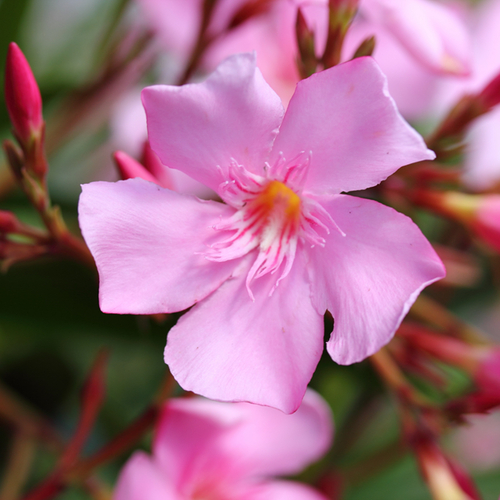
Background
The cardiac glycosides in oleander affect the heart. These chemicals can slow the heart rate down. Some of these chemicals might also kill cancer cells.
People use oleander for heart failure, cancer, epilepsy, and many other conditions, but there is no good scientific evidence to support these uses. There is also no good evidence to support using oleander for COVID-19. Oleander is unsafe to use.
Safety Safety definitions
When applied to the skin: Oleander is possibly unsafe. It can be absorbed into the body and cause serious side effects. Touching oleander sap can cause a rash.
Special Precautions & Warnings:
Pregnancy and breast-feeding: Taking oleander by mouth is likely unsafe while pregnant or breast-feeding. It might cause an abortion or cause birth defects. There isn't enough reliable information to know if oleander is safe to apply to the skin. Stay on the safe side and avoid use.Children: Oleander is likely unsafe when taken by mouth. Taking the oleander leaf, oleander leaf tea, or oleander seed has led to deadly poisonings.
Effectiveness
Dosing & administration
Interactions with pharmaceuticals
Antibiotics (Macrolide antibiotics)
Interaction Rating=Major Do not take this combination.
Taking some antibiotics might increase how much oleander the body absorbs. This might increase the effects and side effects of oleander.
Antibiotics (Tetracycline antibiotics)
Interaction Rating=Major Do not take this combination.
Taking some antibiotics might increase how much oleander the body absorbs. This might increase the effects and side effects of oleander.
Digoxin (Lanoxin)
Interaction Rating=Major Do not take this combination.
Digoxin helps the heart beat more strongly. Oleander also seems to affect the heart. Taking oleander along with digoxin can increase the effects of digoxin and might cause serious heart problems. Do not take oleander if you are taking digoxin without talking to your health care professional.
Medications for inflammation (Corticosteroids)
Interaction Rating=Moderate Be cautious with this combination.
Oleander might affect the heart. Some medications for inflammation can decrease potassium in the body. Low potassium levels can also affect the heart. Taking these products together can increase the risk of side effects.
Quinine
Interaction Rating=Major Do not take this combination.
Quinine might increase the amount of oleander the body absorbs. Taking quinine along with oleander might cause serious heart problems.
Stimulant laxatives
Interaction Rating=Major Do not take this combination.
Oleander might affect the heart. Stimulant laxatives can cause diarrhea and decrease potassium levels. Low potassium levels can also affect the heart. Taking these products together can increase the risk of side effects.
Water pills (Diuretic drugs)
Interaction Rating=Major Do not take this combination.
Oleander might affect the heart. "Water pills" can decrease potassium levels. Low potassium levels can also affect the heart. Taking these products together can increase the risk of side effects.
Interactions with herbs & supplements
Herbs that contain cardiac glycosides: Oleander contains chemicals that can affect the heart. These chemicals are called cardiac glycosides. Using it along with other supplements that also contain cardiac glycosides can increase the risk of heart damage. Examples of supplements that contain cardiac glycosides include black hellebore, foxglove, lily-of-the-valley, and pleurisy root.
Horsetail: Oleander contains chemicals that can affect the heart. Horsetail can decrease potassium levels. Low potassium levels can also affect the heart. Taking these products together can increase the risk of side effects.
Licorice: Oleander contains chemicals that can affect the heart. Licorice can decrease potassium levels. Low potassium levels can also affect the heart. Taking these products together can increase the risk of side effects.
Stimulant laxative herbs: Oleander contains chemicals called cardiac glycosides. Using oleander with stimulant laxative herbs increases the risk of heart damage due to loss of too much potassium. Examples of supplements with this effect include aloe, alder buckthorn, gossypol, rhubarb, and senna.




